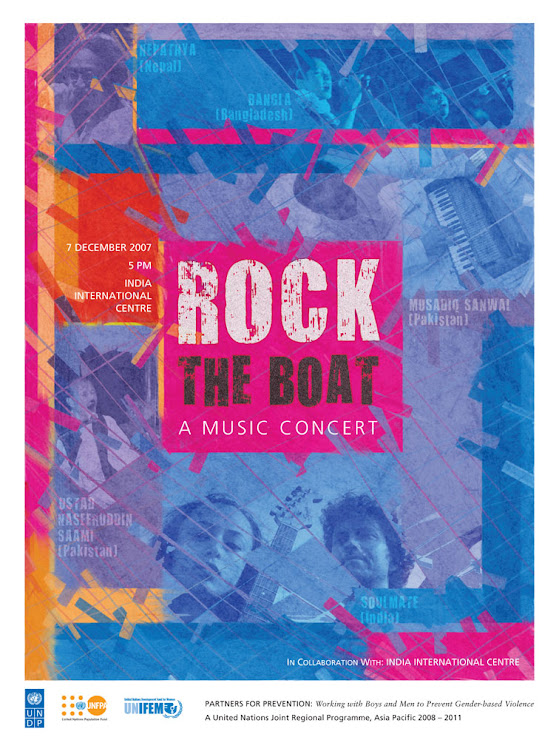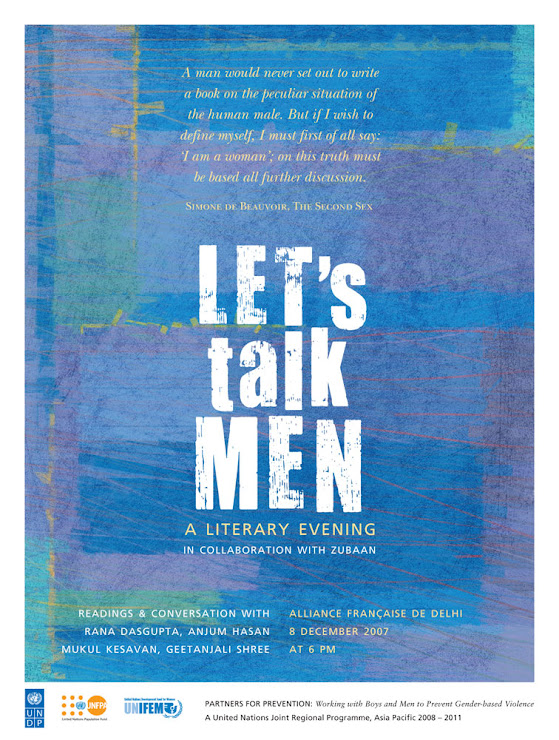
The Exhibition on Masculinity is being held in the lawns behind the main building of Ramjas College. When I arrived there at ten something o’clock, what first struck my eyes was a space cordoned off by half- Shamyanas (if that is what they are called, I mean those man height poles with thick cloth strung between them) with bright buntings, and brighter posters. Inside there was a sprinkling of stalls and students, with many more looking in curiously from the corridors of the science bock and the auditorium that flank the lawn on two sides.
Soon the sprinkling became a steady stream as the students’ curiosity got the better of them. They patiently moved through the exhibition of photographs exploring masculinity from Karol Bagh to Kolkata. Striking photographs of everyday lives of men and their underlying subtexts were up on display. Also on display were the giant size pages of Rahul Roy’s ‘Little Book on Men’ a readable and interesting book that draws on text, drawings, and video frames for its telling.
There were also various stalls displaying books, kits, and even games that centred on the question of masculinity. These stalls were ‘manned’ by Tarshi, Yoda Press, Independent Press Group, Jagori and Men’s Action to Stop Violence Against Women (MASVAW) among others.
While observing all this, I was jerked out of my reverie by the sudden laughter and excitement that erupted out of one of the stalls (the MASVAW one). Moving there, I saw that in place of a carpet there was a giant game of snakes and ladders. Students were throwing a dice the size of a stool and hopping from square to square, some of which led them to climb a ladder or slide down a snake. A closer look revealed that while the principle behind the game was the traditional Snakes and Ladders carrot versus stick divide, the climb up or slide down was based on the plus and minus points of masculine behaviour. Very interesting! The exhibition is on for another two days. I suggest that you should go and check out its various offerings.
Eleven o’ clock and it was time for the theatre performance, Man to Man Talk, by Pranab Mukherjee. The venue was the Ramjas Canteen, much spruced and brushed up since I had eaten stale samosas there over two decades ago. The performance itself turned out to be snippets that resembled a play, and other snippets that were in large doses monologues, diatribes, ramblings all stitched around the theme of masculinity and the politics it involves. I was noticing the students while the play was going on. While a small minority seemed to be amused by the attempt, a good number were riveted by it. When I was leaving, I heard one student asking another, “Are you zipped up?”- zipped up being a term that Pranab had used to connote curbing of aggressive masculinity.
Twelve o’ clock and it was back to the lawns for a panel discussion on Understanding Masculinity and Violence. The original venue had been the Seminar room, but it was felt that it would be more appropriate to have it in the middle of the exhibition where more students could participate. The panel consisted of Dr. Deepak Mehta, Dr. Abhijit Das, Dr. Kalyani Menon- Sen, Dr. Prem Chowdhry, and Rahul Roy as moderator.
Each of the participants interpreted the axis between violence and men in their own unique manner, based on their experience and research.
Dr. Deepak Mehta who has worked with riot victims in Mumbai and elsewhere drew a link between communal violence, masculinity and nationalism. He underlined the connection between such riots and the fact that over eighty percent of the victims were men over eighteen -as an attempt to emasculate (literally in many cases) the ‘other’.
Dr. Kalyani Menon-Sen’s talk centred around the violent sense of love that envelopes masculinity and gives it an almost mystical haze if not a halo. It is as though ‘tough love’ is accepted as a man’s prerogative and preferred over ‘wimpy love’. Women are also complicit in this construction. She drew on folk songs and traditions as well as modern mediums such as films as reinforcing such a construct.
Dr. Prem Chowdhry, with her research on the males of Haryana, drew the connection between rampant unemployment and masculine violence.
Dr. Abhijit Das talked about his personal experiences that led to his involvement in the
Men’s Action to Stop Violence Against Women. He spoke about his shift from a ‘supportive’ role in the feminist movement to an active role in the men’s action against violence on women.
Despite the somewhat thin attendance, the panel discussion was enriching and provided quite a few insights.
Two o’ clock, no lunch, and it is time to rush off to Kirori Mal College for a screening of I am a Man, by Byron Hurt. It turned out to be a pretty interesting film on Afro-Americans and their interpretations masculinity. There was an animated discussion on the meaning of masculinity and the privileges as well as burdens that it entails.
I could not attend the screening of In the Pit, by Juan Carlos Rulfo, at Ramjas College as the timing overlapped with the earlier film, but I believe it to have been an absorbing film.
All in all it was a packed day filled with fun, insight and information. I am looking forward to more tomorrow.




No comments:
Post a Comment